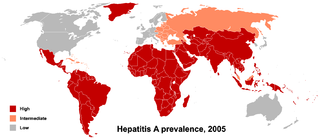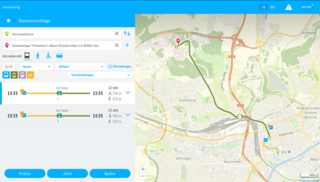Related Research Articles

A geographic information system (GIS) is a type of database containing geographic data, combined with software tools for managing, analyzing, and visualizing those data. In a broader sense, one may consider such a system to also include human users and support staff, procedures and workflows, body of knowledge of relevant concepts and methods, and institutional organizations.
Community health refers to simple health services that are delivered by laymen outside hospitals and clinics. Community health is also the subset of public health that is taught to and practiced by clinicians. Community health volunteers and community health workers work with Primary Care Providers to facilitate entry into, exit from and utilization of the formal health system by community members.
Gravity models are used in various social sciences to predict and describe certain behaviors that mimic gravitational interaction as described in Isaac Newton's laws of gravity. Generally, the social science models contain some elements of mass and distance, which lends them to the metaphor of physical gravity. A gravity model provides an estimate of the volume of flows of, for example, goods, services, or people between two or more locations. This could be the movement of people between cities or the volume of trade between countries.
Primary health care, or PHC, refers to "essential health care" that is based on scientifically sound and socially acceptable methods and technology. This makes universal health care accessible to all individuals and families in a community. PHC initiatives allow for the full participation of community members in implementation and decision making. Services are provided at a cost that the community and the country can afford at every stage of their development in the spirit of self-reliance and self-determination. In other words, PHC is an approach to health beyond the traditional health care system that focuses on health equity-producing social policy. PHC includes all areas that play a role in health, such as access to health services, environment and lifestyle. Thus, primary healthcare and public health measures, taken together, may be considered as the cornerstones of universal health systems. The World Health Organization, or WHO, elaborates on the goals of PHC as defined by three major categories, "empowering people and communities, multisectoral policy and action; and primary care and essential public health functions as the core of integrated health services[1]." Based on these definitions, PHC can not only help an individual after being diagnosed with a disease or disorder, but actively prevent such issues by understanding the individual as a whole.

Health geography is the application of geographical information, perspectives, and methods to the study of health, disease, and health care. Medical geography, a sub-discipline of or sister field of health geography, focuses on understanding spatial patterns of health and disease as related to the natural and social environment. Conventionally, there are two primary areas of research within medical geography: the first deals with the spatial distribution and determinants of morbidity and mortality, while the second deals with health planning, help-seeking behavior, and the provision of health services.

Spatial analysis or spatial statistics includes any of the formal techniques which studies entities using their topological, geometric, or geographic properties. Spatial analysis includes a variety of techniques, many still in their early development, using different analytic approaches and applied in fields as diverse as astronomy, with its studies of the placement of galaxies in the cosmos, to chip fabrication engineering, with its use of "place and route" algorithms to build complex wiring structures. In a more restricted sense, spatial analysis is the technique applied to structures at the human scale, most notably in the analysis of geographic data or transcriptomics data.
In marketing, geodemographic segmentation is a multivariate statistical classification technique for discovering whether the individuals of a population fall into different groups by making quantitative comparisons of multiple characteristics with the assumption that the differences within any group should be less than the differences between groups.
Time geography or time-space geography is an evolving transdisciplinary perspective on spatial and temporal processes and events such as social interaction, ecological interaction, social and environmental change, and biographies of individuals. Time geography "is not a subject area per se", but rather an integrative ontological framework and visual language in which space and time are basic dimensions of analysis of dynamic processes. Time geography was originally developed by human geographers, but today it is applied in multiple fields related to transportation, regional planning, geography, anthropology, time-use research, ecology, environmental science, and public health. According to Swedish geographer Bo Lenntorp: "It is a basic approach, and every researcher can connect it to theoretical considerations in her or his own way."

In the context of spatial analysis, geographic information systems, and geographic information science, a field is a property that fills space, and varies over space, such as temperature or density. This use of the term has been adopted from physics and mathematics, due to their similarity to physical fields (vector or scalar) such as the electromagnetic field or gravitational field. Synonymous terms include spatially dependent variable (geostatistics), statistical surface ( thematic mapping), and intensive property (physics and chemistry) and crossbreeding between these disciplines is common. The simplest formal model for a field is the function, which yields a single value given a point in space (i.e., t = f(x, y, z) )
In human geography, a catchment area is the area from which a location, such as a city, service or institution, attracts a population that uses its services and economic opportunities. Catchment areas may be defined based on from where people are naturally drawn to a location or as established by governments or organizations for the provision of services.

A food desert is an area that has limited access to affordable and nutritious food. In contrast, an area with greater access to supermarkets and vegetable shops with fresh foods may be called a food oasis. The designation considers the type and the quality of food available to the population, in addition to the accessibility of the food through the size and the proximity of the food stores.
The gravity model of migration is a model in urban geography derived from Newton's law of gravity, and used to predict the degree of migration interaction between two places. Newton's law states that: "Any two bodies attract one another with a force that is proportional to the product of their masses and inversely proportional to the square of the distance between them."

Geography is a field of science devoted to the study of the lands, features, inhabitants, and phenomena of Earth. The first recorded use of the word γεωγραφία was as a title of a book by Greek scholar Eratosthenes. Geography is an all-encompassing discipline that seeks an understanding of Earth and its human and natural complexities—not merely where objects are, but also how they have changed and come to be. While geography is specific to Earth, many concepts can be applied more broadly to other celestial bodies in the field of planetary science. One such concept, the first law of geography, proposed by Waldo Tobler, is "everything is related to everything else, but near things are more related than distant things." Geography has been called "the world discipline" and "the bridge between the human and the physical sciences."
Geographic information systems (GISs) and geographic information science (GIScience) combine computer-mapping capabilities with additional database management and data analysis tools. Commercial GIS systems are very powerful and have touched many applications and industries, including environmental science, urban planning, agricultural applications, and others.

GTFS, which stands for General Transit Feed Specification or (originally) Google Transit Feed Specification, defines a common format for public transportation schedules and associated geographic information. GTFS contains only static or scheduled information about public transport services, and is sometimes known as GTFS Static to distinguish it from the GTFS Realtime extension, which defines how information on the realtime status of services can be shared.
A spatial distribution in statistics is the arrangement of a phenomenon across the Earth's surface and a graphical display of such an arrangement is an important tool in geographical and environmental statistics. A graphical display of a spatial distribution may summarize raw data directly or may reflect the outcome of a more sophisticated data analysis. Many different aspects of a phenomenon can be shown in a single graphical display by using a suitable choice of different colours to represent differences.

Head/tail breaks is a clustering algorithm scheme for data with a heavy-tailed distribution such as power laws and lognormal distributions. The heavy-tailed distribution can be simply referred to the scaling pattern of far more small things than large ones, or alternatively numerous smallest, a very few largest, and some in between the smallest and largest. The classification is done through dividing things into large and small things around the arithmetic mean or average, and then recursively going on for the division process for the large things or the head until the notion of far more small things than large ones is no longer valid, or with more or less similar things left only. Head/tail breaks is not just for classification, but also for visualization of big data by keeping the head, since the head is self-similar to the whole. Head/tail breaks can be applied not only to vector data such as points, lines and polygons, but also to raster data like digital elevation model (DEM).

Primary Care Service Areas are geographic areas that are self-sufficient markets of primary care. These areas are designed in a manner such that the majority of patients living in these areas use primary care services form within the area. This ensures that any geographic targeting of policies and resources reach the patients they are meant for. These geographies have been created in Australia, United States and Switzerland using big data and Geographic information systems. In Australia, while they have been developed for the state of New South Wales, they have not found application among policymakers, where, as of 2016 much larger geographies called Primary Health Networks are used for primary care management. However, they have found an especially wide audience amongst policymakers and researchers in the United States, where they were first developed. Thus for example the Health Resources and Services Administration uses them to designate areas of workforce shortage. Primary Care Service Areas are thus for example an appropriate geography for measuring primary care physician supply or geographic access to General practitioners.
A land use regression model is an algorithm often used for analyzing pollution, particularly in densely populated areas.
The uncertain geographic context problem (UGCoP) is a source of statistical bias that can significantly impact the results of spatial analysis when dealing with aggregate data. The UGCoP is very closely related to the Modifiable areal unit problem (MAUP), and like the MAUP, arrises from how we divide the land into aerial units. It is caused by the difficulty, or impossibility, of understanding how phenomena under investigation in different enumeration units interact between enumeration units, and outside of a study area over time. It is particularly important to consider the UGCoP within the discipline of time geography, where phenomena under investigation can move between spatial enumeration units during the study period. Examples of research that needs to consider the UGCoP include food access and human mobility.
References
- Luo, W., Wang, F., 2003a. Spatial accessibility to primary care and physician shortage area designation: a case study in Illinois with GIS approaches. In: Skinner, R., Khan, O. (Eds.), Geographic Information Systems and Health Applications. Idea Group Publishing, Hershey, PA, pp. 260–278.
- Luo, W.; Wang, F. (2003b). "Measures of spatial accessibility to health care in a GIS environment: synthesis and a case study in the Chicago region" (PDF). Environment and Planning B: Planning and Design. 30 (6): 865–884. doi:10.1068/b29120. PMC 8238135 . PMID 34188345.
- Luo, W.; Qi, Y. (2009). "An enhanced two-step floating catchment area (E2SFCA) method for measuring spatial accessibility to primary care physicians" (PDF). Health & Place. 15 (4): 1100–1107. doi:10.1016/j.healthplace.2009.06.002. PMID 19576837.
- Radke, J.; Mu, L. (2000). "Spatial decomposition, modeling and mapping service regions to predict access to social programs". Geographic Information Sciences. 6 (2): 105–112. doi: 10.1080/10824000009480538 . S2CID 33286600.
- Wang, F.; Luo, W. (2005). "Assessing spatial and nonspatial factors for healthcare access: towards an integrated approach to defining health professional shortage areas" (PDF). Health and Place. 11 (2): 131–146. doi:10.1016/j.healthplace.2004.02.003. PMID 15629681.
- Wang, F. 2006. Quantitative Methods and Applications in GIS. London: CRC Press. ISBN 0-8493-2795-4
- McGrail, Matthew R.; Humphreys, John S. (2009). "Measuring spatial accessibility to primary care in rural areas: Improving the effectiveness of the two-step floating catchment area method". Applied Geography. 29 (4): 533–541. doi:10.1016/j.apgeog.2008.12.003.
- Chen, X. (2017). "Take the edge off: A hybrid geographic food access measure". Applied Geography. 87: 149–159. doi:10.1016/j.apgeog.2017.07.013.